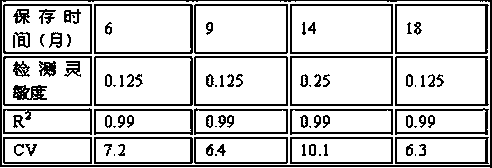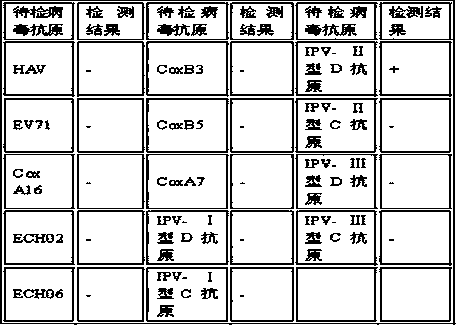Method for detecting pre-coated poliovirus type II D antigen and detection kit and application thereof
A poliomyelitis, quantitative detection method technology, applied in the field of bioengineering, can solve problems such as poor stability of coated microplates, difference in detection results, adverse vaccine quality stability, etc., to improve detection sensitivity and specificity, and reduce detection. and operating errors, reducing the effect of preparation preparation steps
- Summary
- Abstract
- Description
- Claims
- Application Information
AI Technical Summary
Problems solved by technology
Method used
Image
Examples
Embodiment 1
[0038] Example 1 Preparation of antiserum for type Ⅱ poliovirus D antigen
[0039] Centrifuge the inactivated poliovirus through 10-30% sucrose density gradient at 40,000rpm for 4-8 hours, collect the D antigen layer, and use it for the preparation of immune serum after being confirmed as D antigen by electron microscopy; Yes), first immunization, type II monovalent inactivated virus D antigen 10-20ml mixed with Freund's complete adjuvant in equal volume, subcutaneous injection immunization, and then 3 booster immunizations followed by blood collection, serum separation, and microneutralization test Serum neutralizing antibody titer determination.
Embodiment 2
[0040] Example 2 Preparation of bovine (rabbit, sheep) anti-type II poliovirus purified antibody (referred to as anti-II IPV-IgG)
[0041] 1. Take the protein A / G affinity chromatography column, place it at room temperature for 30 minutes, and equilibrate the column with an equilibration solution 5 times the volume of the column; 2. Mix the antiserum and the equilibration solution in an equal volume ratio before loading the sample. Use 10 times the column volume of the equilibrium solution to elute the impurity protein, leaving the target protein; 3. Use 10 times the column volume of the conventional eluent to elute the target protein from the affinity column, collect the eluted peak, and desalt it for later use 4. Determination of protein content by lowrry method to obtain bovine (rabbit, sheep) anti-II IPV-IgG, which is stored below -20°C for later use; the lotion and balance solution are conventional liquids in the prior art.
Embodiment 3
[0042] Example 3 Preparation of enzyme-labeled antibody
[0043] After dissolving 10 mg of horseradish peroxidase in 1 ml of water for injection, add 0.2 ml of NaIO4, let stand for 0.1-1 hour, add 0.5 ml of ethylene glycol solution, let stand for 0.1-1 hour, then mix with 1 ml of purified antibody obtained in step 2 Mix and dialyze overnight; add 0.5ml sodium borohydride, let it stand for 0.1-1 hour, add saturated ammonium sulfate, centrifuge at 15000rpm for 30-60 minutes; take the precipitate and dissolve it and dialyze overnight; obtain bovine (rabbit, sheep) anti-Ⅱ IPV- IgG-HRP, stored at low temperature for future use.
PUM
 Login to View More
Login to View More Abstract
Description
Claims
Application Information
 Login to View More
Login to View More - R&D
- Intellectual Property
- Life Sciences
- Materials
- Tech Scout
- Unparalleled Data Quality
- Higher Quality Content
- 60% Fewer Hallucinations
Browse by: Latest US Patents, China's latest patents, Technical Efficacy Thesaurus, Application Domain, Technology Topic, Popular Technical Reports.
© 2025 PatSnap. All rights reserved.Legal|Privacy policy|Modern Slavery Act Transparency Statement|Sitemap|About US| Contact US: help@patsnap.com



